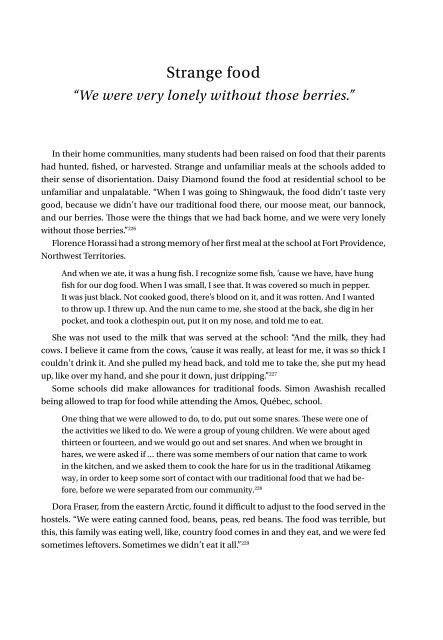The Survivors Speak
1MB8J05
1MB8J05
Create successful ePaper yourself
Turn your PDF publications into a flip-book with our unique Google optimized e-Paper software.
Strange food<br />
“We were very lonely without those berries.”<br />
In their home communities, many students had been raised on food that their parents<br />
had hunted, fished, or harvested. Strange and unfamiliar meals at the schools added to<br />
their sense of disorientation. Daisy Diamond found the food at residential school to be<br />
unfamiliar and unpalatable. “When I was going to Shingwauk, the food didn’t taste very<br />
good, because we didn’t have our traditional food there, our moose meat, our bannock,<br />
and our berries. Those were the things that we had back home, and we were very lonely<br />
without those berries.” 226<br />
Florence Horassi had a strong memory of her first meal at the school at Fort Providence,<br />
Northwest Territories.<br />
And when we ate, it was a hung fish. I recognize some fish, ’cause we have, have hung<br />
fish for our dog food. When I was small, I see that. It was covered so much in pepper.<br />
It was just black. Not cooked good, there’s blood on it, and it was rotten. And I wanted<br />
to throw up. I threw up. And the nun came to me, she stood at the back, she dig in her<br />
pocket, and took a clothespin out, put it on my nose, and told me to eat.<br />
She was not used to the milk that was served at the school: “And the milk, they had<br />
cows. I believe it came from the cows, ’cause it was really, at least for me, it was so thick I<br />
couldn’t drink it. And she pulled my head back, and told me to take the, she put my head<br />
up, like over my hand, and she pour it down, just dripping.” 227<br />
Some schools did make allowances for traditional foods. Simon Awashish recalled<br />
being allowed to trap for food while attending the Amos, Québec, school.<br />
One thing that we were allowed to do, to do, put out some snares. <strong>The</strong>se were one of<br />
the activities we liked to do. We were a group of young children. We were about aged<br />
thirteen or fourteen, and we would go out and set snares. And when we brought in<br />
hares, we were asked if … there was some members of our nation that came to work<br />
in the kitchen, and we asked them to cook the hare for us in the traditional Atikameg<br />
way, in order to keep some sort of contact with our traditional food that we had before,<br />
before we were separated from our community. 228<br />
Dora Fraser, from the eastern Arctic, found it difficult to adjust to the food served in the<br />
hostels. “We were eating canned food, beans, peas, red beans. <strong>The</strong> food was terrible, but<br />
this, this family was eating well, like, country food comes in and they eat, and we were fed<br />
sometimes leftovers. Sometimes we didn’t eat it all.” 229


